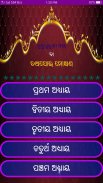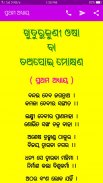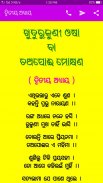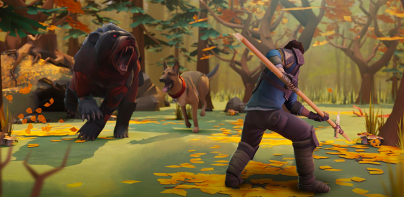









Khudurukuni Osha

Descrição de Khudurukuni Osha
On the Sundays of the month of Bhadrab (Aug-Sept) this festival is observed by the
unmarried girls of the business community of the coastal districts of Orissa. During the
festival Goddess Durga is propitiated Khude Bhaja (Left out particles of rice that are
fried), Kantiali Kakudi (Cucumber having little thorns on it), Lia (fried paddy),
Ukhuda(fried paddy sweetened by molasses) and coconut are the food-offerings given
to the deity. However, the principal food-offering is Khuda which is said to be the
favourite of the Goddess. Therefore, the festival is named as "Khudarankuni" or popularly
'Khudurkuni' which means one who is very eager for khuda.
In the early morning the girls go out collecting flowers required for the ritual. The varieties
are Kaniara, Godibana, Tagara, Malati, Champa, Mandera and Kain. Then they go
to nearby rivers and tanks to have purificatory bath. After this they build tiny temples of
earth or sand and decorate the same with flowers. Paying obeisence to the deity there,
they return to their respective homes. They take two and half mouthfuls of boiled rice
mixed with water without adding salt. Then salt is added. The significance of this act is
not known. After this the, whole day is spent in making garlands and decorating the
image of the Goddess.
In villages generally the deity is worshipped in the Dhinkisala or the place where caddy
is pounced. This place is plastered neatly with cow-dung and the image of the deity is
installed. The floor is painted with floral despins known as Jhoti or Alpana. Garlands
are made to hang like arches. The whole day passes with the arrangement and the rituals
of worship commence in the evening.
After the ritual, are over the girls recite musically the episode of Taapoi which is now
available in print. Eariler this was handed down by oral tradition. The first episode
'Malasri' recounts the killing of the demon by Durga. It is said, that Mahisasura, the terrible
demon became atrocious by getting a boon from Brahma, the creator. Not only
the mankind, but also the Gods got panicky. He became so powerful that even Gods
couldn't kill him. Then all the Gods conferred and went to request the Goddess of
power to kill the demon. Durga agreed and assuming the form of a beautiful damsel
went to Vindhya mountain to pretend penancing. Mahisasura, while out on hunting,
noticed the beautiful damsel and immediately offered to marry her. The damsel
answered that she would only marry that person who would defeat her in duel. Mahisasura
being confident of his power soon agreed to the proposal. A fierce 'duel' ensued
between them; with all her enargy the damsel thrusted a trident violently to the chest of
the demon who was killed. Thus, Durga redeemed the world from the fear and atrocity
of the demon. It is, therefore, believed that the girls worship Durga to be powerful like
Her, to fight evil forces for the goodof the human race.
Nos domingos do mês de Bhadrab (agosto-setembro) este festival é observado pelo
meninas solteiras da comunidade empresarial dos distritos costeiros de Orissa. Durante o
A Deusa do festival Durga é propiciada Khude Bhaja (Partículas de arroz deixadas de fora
frito), Kantiali Kakudi (Pepino com pequenos espinhos), Lia (arroz frito),
Ukhuda (arroz frito adoçado com melaço) e coco são os alimentos oferecidos
para a divindade. No entanto, a principal oferta de alimentos é Khuda, que se diz ser a
favorito da Deusa. Portanto, o festival é nomeado como "Khudarankuni" ou popularmente
'Khudurkuni', que significa aquele que está muito ansioso por khuda.
De manhã cedo as meninas saem coletando flores necessárias para o ritual. As variedades
são Kaniara, Godibana, Tagara, Malati, Champa, Mandera e Kain. Então eles vão
para rios e tanques próximos para ter banho purificatório. Depois disso, eles constroem minúsculos templos de
terra ou areia e decore o mesmo com flores. Prestando obediência à divindade lá,
eles retornam para suas respectivas casas. Eles tomam dois e meia bocados de arroz cozido
misturado com água sem adicionar sal. Então sal é adicionado. O significado deste ato é
não conhecido. Depois disso, todo o dia é gasto em fazer guirlandas e decorar o
imagem da Deusa.
Em aldeias geralmente a divindade é adorada no Dhinkisala ou o lugar onde caddy
é atacado. Este lugar é rebocado ordenadamente com estrume de vaca e a imagem da divindade é
instalado. O chão é pintado com déspotas florais conhecidos como Jhoti ou Alpana. Guirlandas
são feitos para pendurar como arcos. O dia inteiro passa com o arranjo e os rituais
de adoração começa à noite.
Após o ritual, são mais as meninas recitar musicalmente o episódio de Taapoi, que é agora
disponível na impressão. Eariler foi transmitido pela tradição oral. O primeiro episódio
'Malasri' conta a morte do demônio por Durga. Diz-se que Mahisasura, o terrível
demônio tornou-se atroz ao receber uma benção de Brahma, o criador. Não somente
a humanidade, mas também os Deuses ficaram em pânico. Ele se tornou tão poderoso que até os deuses
não podia matá-lo. Então todos os Deuses conferiram e foram pedir a Deusa de
poder para matar o demônio. Durga concordou e assumiu a forma de uma linda donzela
fui para a montanha Vindhya para fingir penitência. Mahisasura, enquanto caçando,
notei a linda donzela e imediatamente me ofereci para casar com ela. A donzela
respondeu que ela só se casaria com aquela pessoa que iria derrotá-la em duelo. Mahisasura
confiante em seu poder logo concordou com a proposta. Um duelo feroz seguiu
entre eles; com toda a sua enargia a donzela empurrou um tridente violentamente para o peito de
o demônio que foi morto. Assim, Durga redimiu o mundo do medo e da atrocidade
do demônio. Acredita-se, portanto, que as meninas adoram Durga para ser poderoso como
Ela, para combater as forças do mal para o bem da raça humana.

























